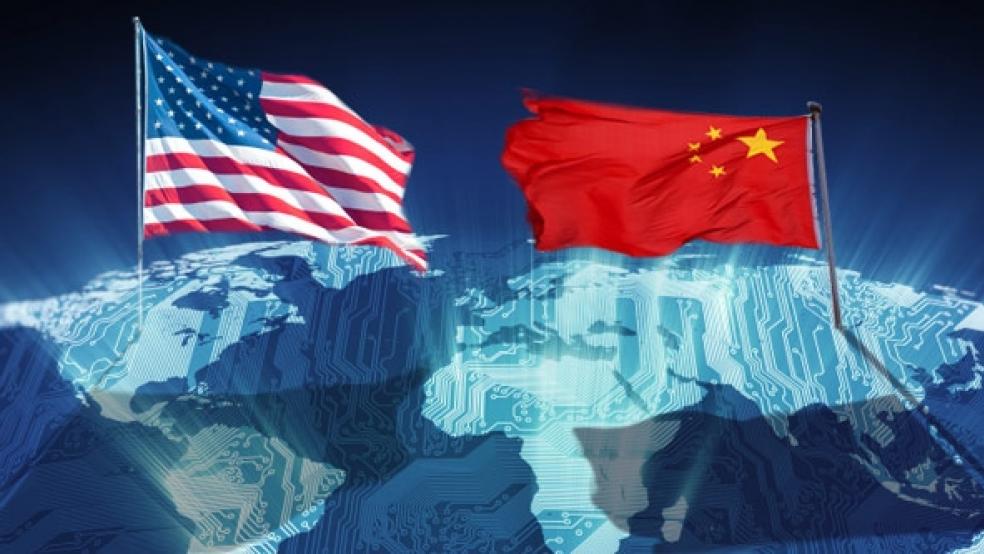A new report warns the Chinese government is engaged in rampant trade law violations with the aim of becoming the global leader in every technology that will dominate the 21st century, including aerospace, biotechnology, information technology, nanotechnology and clean energy.
The report charges China is seeking to become number one in those fields by following an aggressive policy of subsidizing exports, protecting its home market, and engaging in rampant intellectual property theft. It is following a path pioneered by Japan and South Korea in the second half of the 20th century with two major differences: China is ten times the size of those two countries combined, and it is taking a far more aggressive approach to winning the race to become the world’s leader in advanced technology industries.
RELATED: What Happens When China’s Bubble Bursts
“The goal of U.S. policy should be to contain and roll back Chinese mercantilism,” said Robert Atkinson, president of the Information Technology and Innovation Foundation and author of “Enough is Enough: Confronting Chinese Innovation Mercantilism.” “The Chinese strategy is to get as much foreign technology as possible, and they’ll use any means necessary to get it.”
Until now, public concern about the U.S.-China trade friction has been limited. For unions and some state and local officials, the focus has been largely on the loss of jobs in labor-intensive industries like consumer electronics assembly or clothing and furniture manufacturing, which foreign-based multinationals moved to China to take advantage of its low-skilled and low-paid workforce. Apple, Inc., America’s largest corporation by market capitalization, epitomizes the strategy by producing its iPhone and other leading products with over 200,000 Chinese employees, who often work in conditions that violate global labor and environmental standards.
Exporters, meanwhile, have focused on the Chinese government’s policy of deliberately undervaluing its currency, which keeps the price of U.S.-made goods artificially high.
They, too, have begun moving manufacturing to China in order to compete in that fast-growing market, which now has more middle-class consumers than the U.S. and nearly as many as Europe. General Motors, which emerged from the Great Recession as the world’s largest automaker after a successful government rescue, last year sold more cars in China than it sold in the U.S. All those cars were assembled in China.
But in recent years, U.S.-based multinational firms like GM, Intel and General Electric have begun facing an entirely different kind of threat from China, one reminiscent of the challenge posed by Japanese manufacturers in the 1980s. Chinese firms, both state-owned and those supported by government subsidies, are engaging in rampant theft of intellectual property from their joint ventures. Or, they are forcing their U.S. partners to transfer of technology as the price of doing business in China.
Foreign firms also face systematic exclusion from fast-growing Chinese markets for technology goods like computers and cell phones as part of an effort to bolster home-grown producers. Racing to be at the forefront of 21st century manufacturing, the Chinese government has also targeted clean technologies like solar cells and wind turbine production. It’s even begun a program to manufacture wide-body jets, a saturated market currently split between the U.S.’s Boeing and Europe’s Airbus, the report said.
To deal with these emerging economic challenges, Atkinson said, the U.S. needs to beef up its trade enforcement bureaucracy and bring more cases against China and Chinese-owned firms at the World Trade Organization. The U.S. should also pursue a trans-Atlantic partnership with the Europeans to aggressively challenge China’s mercantilist policies, Atkinson said.
He dismissed concerns that a tougher stance on trade will worsen relations with China, which has in recent years beefed up its military and begun playing a more aggressive role in East Asia. “The trade war has already been going on for five or ten years” he said. “The Chinese have shot the most volleys and we’re losing. “Getting tough with them will embolden their reformers – and there are reformers in China,” he added.
The report received a lukewarm endorsement from the main trade association for U.S. businesses active in China – the U.S.-China Business Council. “We’re much more sober about the issue,” said Marc Ross, a spokesman for the 250-member group, whose roster includes most of the Fortune 500 firms active in East Asia. “Obviously we want to create an environment where everybody is playing by the same rules, but we’re less bombastic than others. On balance, it’s a good relationship.”
One reason why U.S. firms are hesitant to openly criticize Chinese trade practices is that they fear retaliation by the Chinese government or exclusion from the booming Chinese market, critics say. For instance, last fall U.S.-based solar cell manufacturers filed atrade complaint against China at the International Trade Commission, which issued a preliminary ruling that China heavily subsidized its exports in an attempt to win control of the U.S. market. Only one of the seven firms mentioned in the complaint – SolarWorld of Portland, Oregon – was willing to be named in the public documents, since most of the others also have operations in China, which has a booming domestic market for solar cells.
“There’s discrimination against foreign firms,” said Sen. Jeff Merkle, D-Ore., who endorsed the report’s findings. “There’s retaliation against U.S. companies that complain.”





